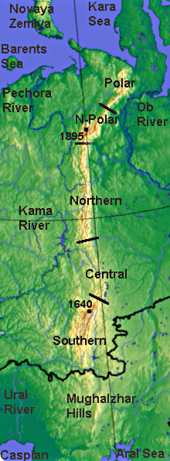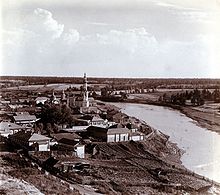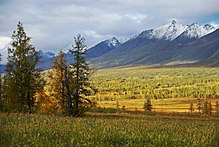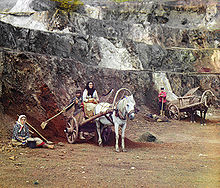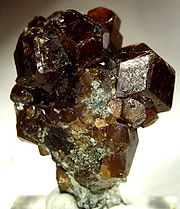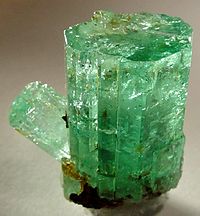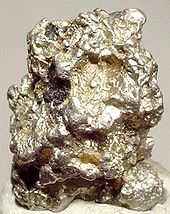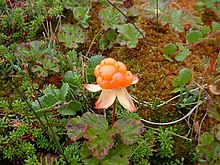As attested by
Sigismund von Herberstein,
in the 16th century Russians called the range by a variety of names
derived from the Russian words for rock (stone) and belt. The modern
Russian name for the Urals (Урал,
Ural), first appearing in the 16th–17th century when the
Russian conquest of Siberia
was in its heroic phase, was initially applied to its southern parts
and gained currency as the name of the entire range during the 18th
century. It might have been a borrowing from either
Turkic "stone belt" (
Bashkir, where the same name is used for the range), or
Ob-Ugric. From the 13th century, in
Bashkortostan there has been a
legend about a hero named Ural.
He sacrificed his life for the sake of his people and they poured a
stone pile over his grave, which later turned into the Ural Mountains. Possibilities include Bashkir
үр "elevation; upland" and Mansi
ур ала "mountain peak, top of the mountain",
V.N. Tatischev believes that this
oronym is set to "belt" and associates it with the Turkic verb oralu- "gird". I.G. Dobrodomov suggests a transition from
Aral to Ural explained on the basis of ancient
Bulgar-
Chuvash dialects. Geographer E.V. Hawks believes that the name goes back to the Bashkir folklore
Ural-Batyr. The
Evenk geographical term
era "mountain" has also been theorized. Finno-Ugrist scholars consider Ural deriving from the
Ostyak word
urr meaning "chain of mountains".
Turkologists,
on the other hand, have achieved majority support for their assertion
that 'ural' in Tatar means a belt, and recall that an earlier name for
the range was 'stone belt'.
History
As Middle-Eastern merchants traded with the
Bashkirs and other people living on the western slopes of the Ural as far north as
Great Perm, since at least the 10th century medieval
mideastern geographers
had been aware of the existence of the mountain range in its entirety,
stretching as far as to the Arctic Ocean in the north. The first Russian
mention of the mountains to the east of the East European Plain is
provided by the
Primary Chronicle, when it describes the
Novgorodian expedition to the upper reaches of the
Pechora in 1096. During the next few centuries Novgorodians engaged in
fur trading with the local population and collected tribute from
Yugra and Great Perm, slowly expanding southwards. The rivers
Chusovaya and
Belaya were first mentioned in the chronicles of 1396 and 1468, respectively. In 1430 the town of
Solikamsk (Kama Salt) was founded on the
Kama at the foothills of the Ural, where salt was
produced in open pans.
Ivan III of Moscow
captured Perm, Pechora and Yugra from the declining Novgorod Republic
in 1472. With the excursions of 1483 and 1499–1500 across the Ural
Moscow managed to subjugate Yugra completely.
Nevertheless, around that time early 16th century Polish geographer
Maciej of Miechów in his influential
Tractatus de duabus Sarmatiis
(1517) argued that there were no mountains in Eastern Europe at all,
challenging the point of view of some authors of Classical antiquity,
popular during the
Renaissance. Only after Sigismund von Herberstein in his
Notes on Muscovite Affairs (1549) had reported, following Russian sources, that there are mountains behind the Pechora and identified them with the
Riphean Mountains and
Hyperboreans of ancient authors, did the existence of the Ural, or at least of its northern part, become firmly established in the
Western geography. The Middle and Southern Ural were still largely unavailable and unknown to the Russian or Western European geographers.
In the 1550s, after the
Tsardom of Russia had defeated the
Khanate of Kazan
and proceeded to gradually annex the lands of the Bashkirs, the
Russians finally reached the southern part of the mountain chain. In
1574 they founded
Ufa.
The upper reaches of the Kama and Chusovaya in the Middle Ural, still
unexplored, as well as parts of Transuralia still held by the hostile
Siberian Khanate, were granted to the
Stroganovs by several decrees of the tsar in 1558–1574. The Stroganovs' land provided the staging ground for
Yermak's
incursion into Siberia. Yermak crossed the Ural from the Chusovaya to the
Tagil around 1581. In 1597 Babinov's road was built across the Ural from Solikamsk to the valley of the
Tura, where the town of
Verkhoturye
(Upper Tura) was founded in 1598. Customs was established in
Verkhoturye shortly thereafter and the road was made the only legal
connection between European Russia and Siberia for a long time. In 1648
the town of
Kungur was founded at the western foothills of the Middle Ural. During the 17th century the first deposits of
iron and
copper ores,
mica,
gemstones and other minerals were discovered in the Ural.
Iron and copper
smelting works emerged. They multiplied particularly quickly during the reign of
Peter I of Russia. In 1720–1722 he commissioned
Vasily Tatishchev to oversee and develop the mining and smelting works in the Ural. Tatishchev proposed a new copper smelting factory in
Yegoshikha, which would eventually become the core of the city of
Perm and a new iron smelting factory on the
Iset, which would become the largest in the world at the time of construction and give birth to the city of
Yekaterinburg. Both factories were actually founded by Tatishchev's successor,
Georg Wilhelm de Gennin, in 1723. Tatishchev returned to the Ural on the order of
Empress Anna
to succeed de Gennin in 1734–1737. Transportation of the output of the
smelting works to the markets of European Russia necessitated the
construction of the
Siberian Route
from Yekaterinburg across the Ural to Kungur and Yegoshikha (Perm) and
further to Moscow, which was completed in 1763 and rendered Babinov's
road obsolete. In 1745 gold was discovered in the Ural at
Beryozovskoye and later at other deposits. It has been mined since 1747.
The first ample geographic survey of the Ural Mountains was
completed in the early 18th century by the Russian historian and
geographer Vasily Tatishchev under the orders of Peter I. Earlier, in
the 17th century, rich ore deposits were discovered in the mountains and
their systematic extraction began in the early 18th century, eventually
turning the region into the largest mineral base of Russia.
One of the first scientific descriptions of the mountains was
published in 1770–71. Over the next century, the region was studied by
scientists from a number of countries, including Russia (geologist
Alexander Karpinsky, botanist
Porfiry Krylov and zoologist
Leonid Sabaneyev), the United Kingdom (geologist Sir
Roderick Murchison), France (paleontologist
Édouard de Verneuil), and Germany (naturalist
Alexander von Humboldt, geologist
Alexander Keyserling). In 1845, Murchison, who had according to
Encyclopædia Britannica "compiled the first geologic map of the Ural in 1841", published
The Geology of Russia in Europe and the Ural Mountains with de Verneuil and Keyserling.
The first railway across the Ural had been built by 1878 and linked Perm to Yekaterinburg via
Chusovoy,
Kushva and
Nizhny Tagil. In 1890 a railway linked Ufa and
Chelyabinsk via
Zlatoust. In 1896 this section became a part of the
Trans-Siberian Railway.
In 1909 yet another railway connecting Perm and Yekaterinburg passed
through Kungur by the way of the Siberian Route. It has eventually
replaced the Ufa – Chelyabinsk section as the main trunk of the
Trans-Siberian railway.
The highest peak of the Ural,
Mount Narodnaya, (elevation 1,895 m (6,217 ft)) was identified in 1927.
Geography and topography
The Ural Mountains extend about 2,500 km (1,600 mi) from the
Kara Sea to the
Kazakh Steppe
along the border of Kazakhstan. Vaygach Island and the island of Novaya
Zemlya form a further continuation of the chain on the north.
Geographically this range marks the northern part of the border between
the continents of Europe and Asia. Its highest peak is Mount Narodnaya,
approximately 1,895 m (6,217 ft) in elevation.
By topography and other natural features, the Urals are divided, from
north to south, into the Polar (or Arctic), Nether-Polar (or
Sub-Arctic), Northern, Central and Southern parts.
Polar Ural
The
Polar Urals extend for about 385 kilometers (239 mi) from Mount
Konstantinov Kamen in the north to the Khulga River in the south; they
have an area of about 25,000 km2 (9,700 sq mi) and a strongly
dissected relief. The maximum height is 1,499 m (4,918 ft) at Payer
Mountain and the average height is 1,000 to 1,100 m (3,300 to 3,600 ft).
The mountains of the Polar Ural have exposed rock with sharp ridges, though flattened or rounded tops are also found.
Nether-polar Ural
The Nether-Polar Ural are higher, and up to 150 km (93 mi) wider than
the Polar Urals. They include the highest peaks of the range: Mount
Narodnaya (1,895 m (6,217 ft)),
Mount Karpinsky (1,878 m (6,161 ft)) and
Manaraga
(1,662 m (5,453 ft)). They extend for more than 225 km (140 mi) south
to the Shchugor River. The many ridges are sawtooth shaped and dissected
by river valleys. Both Polar and Nether-Polar Urals are typically
Alpine; they bear traces of
Pleistocene glaciation, along with permafrost and extensive modern glaciation, including 143 extant glaciers.
Northern Ural
The
Northern Ural consist of a series of parallel ridges up to
1,000–1,200 m (3,300–3,900 ft) in height and longitudinal hollows. They
are elongated from north to south and stretch for about 560 km (350 mi)
from the Usa River. Most of the tops are flattened, but those of the
highest mountains, such as Telposiz, 1,617 m (5,305 ft) and Konzhakovsky
Stone, 1,569 m (5,148 ft) have a dissected topography. Intensive
weathering has produced vast areas of eroded stone on the mountain
slopes and summits of the northern areas.
Middle Ural
The
Central Ural are the lowest part of the Ural, with smooth mountain
tops, the highest mountain being 994 m (3,261 ft) (Basegi); they extend
south from the
Ufa River.
Southern Ural
The relief of the Southern Ural is more complex, with numerous
valleys and parallel ridges directed south-west and meridionally. The
range includes the
Ilmensky Mountains separated from the main ridges by the
Miass River. The maximum height is 1,640 m (5,380 ft) (
Mount Yamantau) and the width reaches 250 km (160 mi). Other notable peaks lie along the
Iremel
mountain ridge (Bolshoy Iremel and Maly Iremel). The Southern Urals
extend some 550 km (340 mi) up to the sharp westward bend of the Ural
River and terminate in the wide
Mughalzhar Hills.
Geology
Wooded Ural Mountains in winter
The western slope of the Ural Mountains has predominantly
karst topography, especially in the
Sylva River basin, which is a tributary of the
Chusovaya River.
It is composed of severely eroded sedimentary rocks (sandstones and
limestones) that are about 350 million years old. There are many
caves,
sinkholes
and underground streams. The karst topography is much less developed on
the eastern slopes. The eastern slopes are relatively flat, with some
hills and rocky outcrops and contain alternating volcanic and
sedimentary layers dated to the middle Paleozoic Era. Most high mountains consist of weather-resistant rocks such as
quartzite,
schist and
gabbro that are between 570 and 395 million years old. The river valleys are underlain by limestone.
The Ural Mountains contain about 48 species of economically valuable
ores and economically valuable minerals. Eastern regions are rich in
chalcopyrite,
nickel oxide,
gold,
platinum,
chromite and
magnetite ores, as well as in
coal (
Chelyabinsk Oblast),
bauxite,
talc,
fireclay and abrasives. The Western Urals contain deposits of coal, oil, natural gas (Ishimbay and Krasnokamsk areas) and
potassium salts. Both slopes are rich in
bituminous coal and
lignite,
and the largest deposit of bituminous coal is in the north (Pechora
field). The specialty of the Urals is precious and semi-precious stones,
such as
emerald,
amethyst,
aquamarine,
jasper,
rhodonite,
malachite and
diamond. Some of the deposits, such as the magnetite ores at
Magnitogorsk, are already nearly depleted.
Rivers and lakes
Many rivers originate in the Ural Mountains. The western slopes south
of the border between the Komi Republic and Perm Krai and the eastern
slopes south of approximately 54°30'N drain into the
Caspian Sea via the Kama and Ural River basins. The tributaries of the Kama include the
Vishera,
Chusovaya, and Belaya and originate on both the eastern and western
slopes. The rest of the Urals drain into the Arctic Ocean, mainly via
the Pechora basin in the west, which includes the
Ilych, Shchugor, and the
Usa, and via the
Ob basin in the east, which includes the
Tobol,
Tavda, Iset, Tura and
Severnaya Sosva.
The rivers are frozen for more than half the year. Generally, the
western rivers have higher flow volume than the eastern ones, especially
in the Northern and Nether-Polar regions. Rivers are slower in the
Southern Urals. This is because of low precipitation and the relatively
warm climate resulting in less snow and more evaporation.
The mountains contain a number of deep lakes.
The eastern slopes of the Southern and Central Urals have most of
these, among the largest of which are the Uvildy, Itkul, Turgoyak, and
Tavatuy lakes.
The lakes found on the western slopes are less numerous and also
smaller. Lake Bolshoye Shchuchye, the deepest lake in the Polar Urals,
is 136 meters (446 ft) deep. Other lakes, too, are found in the glacial
valleys of this region. Spas and sanatoriums have been built to take
advantage of the medicinal muds found in some of the mountain lakes.
Climate
The
climate of the Urals is continental. The mountain ridges, elongated from
north to south, effectively absorb sunlight thereby increasing the
temperature. The areas west of the Ural Mountains are 1–2 °C
(1.8–3.6 °F) warmer in winter than the eastern regions because the
former are warmed by Atlantic winds whereas the eastern slopes are
chilled by Siberian air masses. The average January temperatures
increase in the western areas from −20 °C (−4 °F) in the Polar to −15 °C
(5 °F) in the Southern Urals and the corresponding temperatures in July
are 10 °C (50 °F) and 20 °C (68 °F). The western areas also receive
more rainfall than the eastern ones by 150–300 mm (5.9–11.8 in) per
year. This is because the mountains trap clouds from the Atlantic Ocean.
The highest precipitation, approximately 1,000 mm (39 in), is in the
Northern Urals with up to 1,000 cm (390 in) snow. The eastern areas
receive from 500–600 mm (20–24 in) in the north to 300–400 mm (12–16 in)
in the south. Maximum precipitation occurs in the summer: the winter is
dry because of the
Siberian High.
.
Flora
The landscapes of the Urals vary with both latitude and longitude and
are dominated by forests and steppes. The southern area of the
Mughalzhar Hills is a semidesert. Steppes lie mostly in the southern and
especially south-eastern Urals. Meadow steppes have developed on the
lower parts of mountain slopes and are covered with
zigzag and
mountain clovers,
Serratula gmelinii,
dropwort,
meadow-grass and
Bromus inermis,
reaching the height of 60–80 cm. Much of the land is cultivated. To the
south, the meadow steppes become more sparse, dry and low. The steep
gravelly slopes of the mountains and hills of the eastern slopes of the
Southern Urals are mostly covered with rocky steppes. River valleys
contain
willow,
poplar and
caragana shrubs.
Forest landscapes of the Urals are diverse, especially in the
southern part. The western areas are dominated by dark coniferous taiga
forests which change to mixed and deciduous forests in the south. The
eastern mountain slopes have light coniferous taiga forests. The
Northern Urals are dominated by conifers, namely
Siberian fir,
Siberian pine,
Scots pine,
Siberian spruce,
Norway spruce and
Siberian larch, as well as by
silver and
downy birches.
The forests are much sparser in the Polar Urals. Whereas in other parts
of the Ural Mountains they grow up to an altitude of 1000 m, in the
Polar Urals the
tree line is at 250–400 m. The polar forests are low and are mixed with swamps, lichens, bogs and shrubs.
Dwarf birch, mosses and berries (
blueberry,
cloudberry,
black crowberry,
etc.) are abundant. The forests of the Southern Urals are the most
diverse in composition: here, together with coniferous forests are also
abundant broadleaf tree species such as
English oak,
Norway maple and elm. The
Virgin Komi Forests in the northern Urals are recognized as a
World Heritage site.
Fauna
The Ural forests are inhabited by animals typical of Siberia, such as elk, brown bear, fox, wolf,
wolverine,
lynx, squirrel, and
sable
(north only). Because of the easy accessibility of the mountains there
are no specifically mountainous species. In the Middle Urals, one can
see a rare mixture of sable and pine marten named kidus. In the Southern
Urals,
badger and
black polecat are common. Reptiles and amphibians live mostly in the Southern and Central Ural and are represented by the
common viper, lizards and
grass snakes. Bird species are represented by
capercaillie,
black grouse,
hazel grouse,
spotted nutcracker, and cuckoos. In summers, the South and Middle Urals are visited by songbirds, such as
nightingale and
redstart.
Ecology
The
continuous and intensive economic development of the last centuries has
affected the fauna, and wildlife is much diminished around all
industrial centers. During World War II, hundreds of factories were
evacuated from Western Russia before the German occupation, flooding the
Urals with industry. The conservation measures include establishing
national wildlife parks. There are nine
strict nature reserves in the Urals: the
Ilmen, the oldest one, mineralogical reserve founded in 1920 in Chelyabinsk Oblast,
Pechora-Ilych in the Komi Republic,
Bashkir and its former branch
Shulgan-Tash in Bashkortostan,
Visim in Sverdlovsk Oblast,
Southern Ural in Bashkortostan,
Basegi in Perm Krai,
Vishera in Perm Krai and
Denezhkin Kamen in Sverdlovsk Oblast.
The area has also been severely damaged by the
plutonium-producing facility
Mayak opened in Chelyabinsk-40 (later called Chelyabinsk-65,
Ozyorsk), in the Southern Ural, after World War II. Its plants went into operation in 1948 and, for the first ten years, dumped unfiltered radioactive waste into the
Techa River and
Lake Karachay.
In 1990, efforts were underway to contain the radiation in one of the
lakes, which was estimated at the time to expose visitors to 500
millirem per day.
As of 2006, 500 mrem in the natural environment was the upper limit of
exposure considered safe for a member of the general public in an entire
year (though workplace exposure over a year could exceed that by a
factor of 10). Over 23,000 km
2
(8,900 sq mi) of land were contaminated in 1957 from a storage tank
explosion, only one of several serious accidents that further polluted
the region. The
1957 accident expelled 20 million
curies of radioactive material, 90% of which settled into the land immediately around the facility. Although some reactors of Mayak were shut down in 1987 and 1990, the facility keeps producing plutonium.
Cultural significance
The
Urals have been viewed by Russians as a "treasure box" of mineral
resources, which were the basis for its extensive industrial
development. In addition to iron and copper the Urals were a source of
gold,
malachite,
alexandrite, and other gems such as those used by the court jeweller
Fabergé. As Russians in other regions gather mushrooms or berries, Uralians gather mineral specimens and gems.
Dmitry Mamin-Sibiryak (1852–1912)
Pavel Bazhov (1879–1950), as well as
Aleksey Ivanov and Olga Slavnikova, post-Soviet writers, have written of the region.
The region served as a military stronghold during
Peter the Great's
Great Northern War with Sweden, during Stalin's rule when the
Magnitogorsk Metallurgical Complex
was built and Russian industry relocated to the Urals during the Nazi
advance at the beginning of World War II, and as the center of the
Soviet nuclear industry during the Cold War. Extreme levels of air,
water, and radiological contamination and pollution by industrial wastes
resulted. Population exodus resulted, and economic depression at the
time of the collapse of the Soviet Union, but in post-Soviet times
additional mineral exploration, particularly in the northern Urals, has
been productive and the region has attracted industrial investment.





